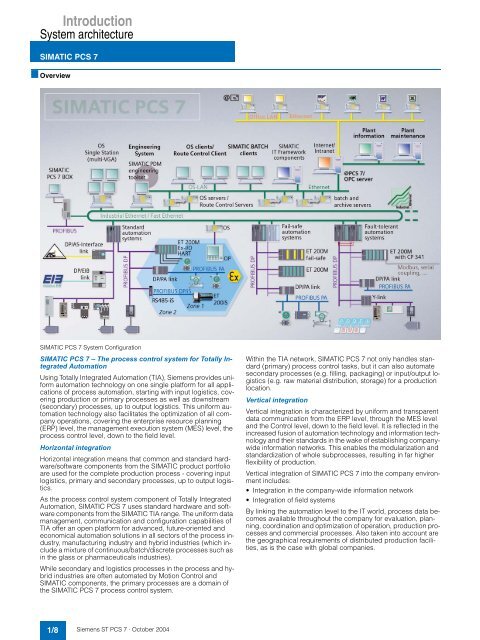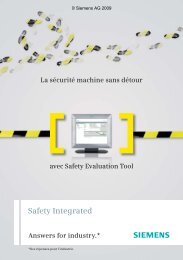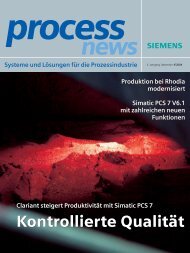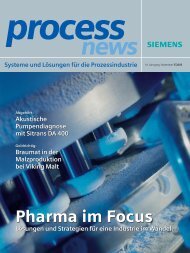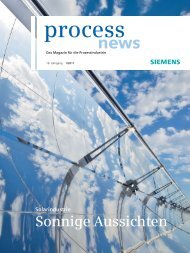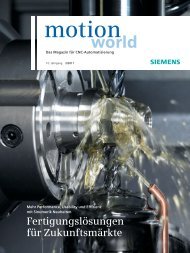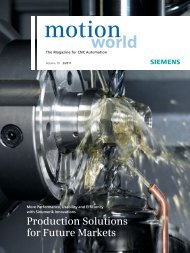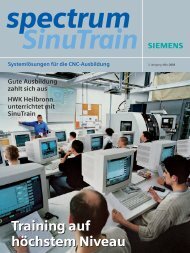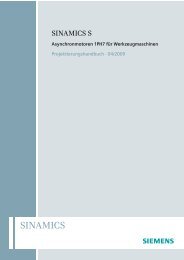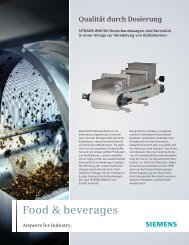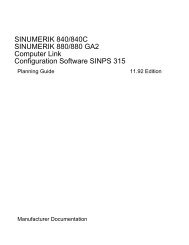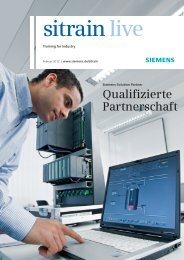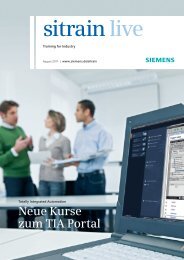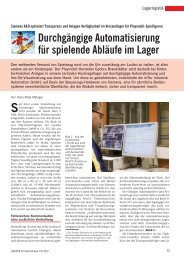Engineering System - Siemens Automation and Drives Group
Engineering System - Siemens Automation and Drives Group
Engineering System - Siemens Automation and Drives Group
Create successful ePaper yourself
Turn your PDF publications into a flip-book with our unique Google optimized e-Paper software.
Introduction<br />
<strong>System</strong> architecture<br />
SIMATIC PCS 7<br />
■ Overview<br />
SIMATIC PCS 7 <strong>System</strong> Configuration<br />
SIMATIC PCS 7 – The process control system for Totally Integrated<br />
<strong>Automation</strong><br />
Using Totally Integrated <strong>Automation</strong> (TIA), <strong>Siemens</strong> provides uniform<br />
automation technology on one single platform for all applications<br />
of process automation, starting with input logistics, covering<br />
production or primary processes as well as downstream<br />
(secondary) processes, up to output logistics. This uniform automation<br />
technology also facilitates the optimization of all company<br />
operations, covering the enterprise resource planning<br />
(ERP) level, the management execution system (MES) level, the<br />
process control level, down to the field level.<br />
Horizontal integration<br />
Horizontal integration means that common <strong>and</strong> st<strong>and</strong>ard hardware/software<br />
components from the SIMATIC product portfolio<br />
are used for the complete production process - covering input<br />
logistics, primary <strong>and</strong> secondary processes, up to output logistics.<br />
As the process control system component of Totally Integrated<br />
<strong>Automation</strong>, SIMATIC PCS 7 uses st<strong>and</strong>ard hardware <strong>and</strong> software<br />
components from the SIMATIC TIA range. The uniform data<br />
management, communication <strong>and</strong> configuration capabilities of<br />
TIA offer an open platform for advanced, future-oriented <strong>and</strong><br />
economical automation solutions in all sectors of the process industry,<br />
manufacturing industry <strong>and</strong> hybrid industries (which include<br />
a mixture of continuous/batch/discrete processes such as<br />
in the glass or pharmaceuticals industries).<br />
While secondary <strong>and</strong> logistics processes in the process <strong>and</strong> hybrid<br />
industries are often automated by Motion Control <strong>and</strong><br />
SIMATIC components, the primary processes are a domain of<br />
the SIMATIC PCS 7 process control system.<br />
1/8<br />
<strong>Siemens</strong> ST PCS 7 · October 2004<br />
Within the TIA network, SIMATIC PCS 7 not only h<strong>and</strong>les st<strong>and</strong>ard<br />
(primary) process control tasks, but it can also automate<br />
secondary processes (e.g. filling, packaging) or input/output logistics<br />
(e.g. raw material distribution, storage) for a production<br />
location.<br />
Vertical integration<br />
Vertical integration is characterized by uniform <strong>and</strong> transparent<br />
data communication from the ERP level, through the MES level<br />
<strong>and</strong> the Control level, down to the field level. It is reflected in the<br />
increased fusion of automation technology <strong>and</strong> information technology<br />
<strong>and</strong> their st<strong>and</strong>ards in the wake of establishing companywide<br />
information networks. This enables the modularization <strong>and</strong><br />
st<strong>and</strong>ardization of whole subprocesses, resulting in far higher<br />
flexibility of production.<br />
Vertical integration of SIMATIC PCS 7 into the company environment<br />
includes:<br />
Integration in the company-wide information network<br />
Integration of field systems<br />
By linking the automation level to the IT world, process data becomes<br />
available throughout the company for evaluation, planning,<br />
coordination <strong>and</strong> optimization of operation, production processes<br />
<strong>and</strong> commercial processes. Also taken into account are<br />
the geographical requirements of distributed production facilities,<br />
as is the case with global companies.


